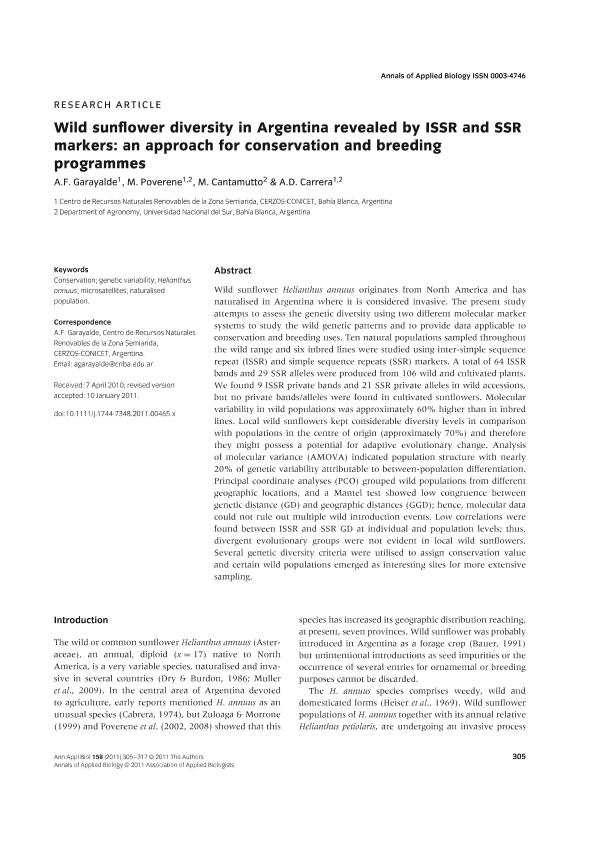Mostrar el registro sencillo del ítem
dc.contributor.author
Garayalde, Antonio Francisco

dc.contributor.author
Poverene, María Mónica

dc.contributor.author
Cantamutto, Miguel Ángel

dc.contributor.author
Carrera, Alicia Delia

dc.date.available
2019-05-28T17:59:31Z
dc.date.issued
2011-05-29
dc.identifier.citation
Garayalde, Antonio Francisco; Poverene, María Mónica; Cantamutto, Miguel Ángel; Carrera, Alicia Delia; Wild sunflower diversity in Argentina revealed by ISSR and SSR markers: An approach for conservation and breeding programmes; Wiley Blackwell Publishing, Inc; Annals of Applied Biology; 158; 3; 29-5-2011; 305-317
dc.identifier.issn
0003-4746
dc.identifier.uri
http://hdl.handle.net/11336/77326
dc.description.abstract
Wild sunflower Helianthus annuus originates from North America and has naturalised in Argentina where it is considered invasive. The present study attempts to assess the genetic diversity using two different molecular marker systems to study the wild genetic patterns and to provide data applicable to conservation and breeding uses. Ten natural populations sampled throughout the wild range and six inbred lines were studied using inter-simple sequence repeat (ISSR) and simple sequence repeats (SSR) markers. A total of 64 ISSR bands and 29 SSR alleles were produced from 106 wild and cultivated plants. We found 9 ISSR private bands and 21 SSR private alleles in wild accessions, but no private bands/alleles were found in cultivated sunflowers. Molecular variability in wild populations was approximately 60% higher than in inbred lines. Local wild sunflowers kept considerable diversity levels in comparison with populations in the centre of origin (approximately 70%) and therefore they might possess a potential for adaptive evolutionary change. Analysis of molecular variance (AMOVA) indicated population structure with nearly 20% of genetic variability attributable to between-population differentiation. Principal coordinate analyses (PCO) grouped wild populations from different geographic locations, and a Mantel test showed low congruence between genetic distance (GD) and geographic distances (GGD); hence, molecular data could not rule out multiple wild introduction events. Low correlations were found between ISSR and SSR GD at individual and population levels; thus, divergent evolutionary groups were not evident in local wild sunflowers. Several genetic diversity criteria were utilised to assign conservation value and certain wild populations emerged as interesting sites for more extensive sampling.
dc.format
application/pdf
dc.language.iso
eng
dc.publisher
Wiley Blackwell Publishing, Inc

dc.rights
info:eu-repo/semantics/openAccess
dc.rights.uri
https://creativecommons.org/licenses/by-nc-sa/2.5/ar/
dc.subject
Conservation
dc.subject
Genetic Variability
dc.subject
Helianthus Annuus
dc.subject
Microsatellites
dc.subject
Naturalised Population
dc.subject.classification
Otras Ciencias Biológicas

dc.subject.classification
Ciencias Biológicas

dc.subject.classification
CIENCIAS NATURALES Y EXACTAS

dc.title
Wild sunflower diversity in Argentina revealed by ISSR and SSR markers: An approach for conservation and breeding programmes
dc.type
info:eu-repo/semantics/article
dc.type
info:ar-repo/semantics/artículo
dc.type
info:eu-repo/semantics/publishedVersion
dc.date.updated
2019-05-14T14:06:29Z
dc.journal.volume
158
dc.journal.number
3
dc.journal.pagination
305-317
dc.journal.pais
Reino Unido

dc.journal.ciudad
Londres
dc.description.fil
Fil: Garayalde, Antonio Francisco. Consejo Nacional de Investigaciones Científicas y Técnicas. Centro Científico Tecnológico Conicet - Bahía Blanca. Centro de Recursos Naturales Renovables de la Zona Semiárida. Universidad Nacional del Sur. Centro de Recursos Naturales Renovables de la Zona Semiárida; Argentina
dc.description.fil
Fil: Poverene, María Mónica. Consejo Nacional de Investigaciones Científicas y Técnicas. Centro Científico Tecnológico Conicet - Bahía Blanca. Centro de Recursos Naturales Renovables de la Zona Semiárida. Universidad Nacional del Sur. Centro de Recursos Naturales Renovables de la Zona Semiárida; Argentina
dc.description.fil
Fil: Cantamutto, Miguel Ángel. Universidad Nacional del Sur. Departamento de Agronomía; Argentina
dc.description.fil
Fil: Carrera, Alicia Delia. Consejo Nacional de Investigaciones Científicas y Técnicas. Centro Científico Tecnológico Conicet - Bahía Blanca. Centro de Recursos Naturales Renovables de la Zona Semiárida. Universidad Nacional del Sur. Centro de Recursos Naturales Renovables de la Zona Semiárida; Argentina
dc.journal.title
Annals of Applied Biology

dc.relation.alternativeid
info:eu-repo/semantics/altIdentifier/url/https://onlinelibrary.wiley.com/doi/pdf/10.1111/j.1744-7348.2011.00465.x
dc.relation.alternativeid
info:eu-repo/semantics/altIdentifier/doi/http://dx.doi.org/10.1111/j.1744-7348.2011.00465.x
Archivos asociados
